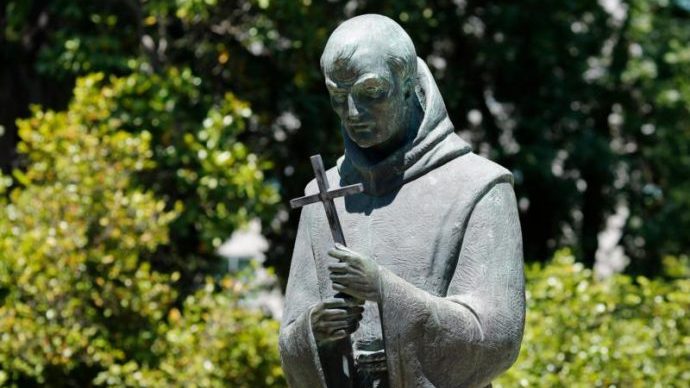As statues of St. Junípero Serra continue to be vandalized in the United States, a Spanish bishop defended the evangelizer of California in the place where the 18th century Franciscan saint was baptized.
Bishop Sebastià Taltavull of Majorca visited the shrine of Petra on Tuesday, to mark the patronal feast of St. Praxedis, a second century Roman martyr. The biography of this woman served as a launching pad for the prelate to speak of the “martyrdom” of the sculptures of St. Junípero Serra and what he sees as an injustice in the undervaluing the legacy of a saint who “can precisely be considered the first activist against the death penalty, so fashionable in the United States today.”
Taltavull regretted that “the media and anonymous blogs” collect so much “bad information,” and said that “suffering persecution is part of the Christian DNA.”
The bishop also spoke in favor of a normalized presence of believers in society and rejected the “movements of professors who aim to remove from the classrooms not only the teaching of religion, but the Catholic culture itself.”
“Can you imagine what would be of Petra without all its religious symbolism?” he asked.
Petra is a town in the Mediterranean island of Majorca, in the Balearic Islands. The world renown travel guide Lonely Planet defines Petra as a “quiet, comely midland town, its former prominence demonstrated by long streets of solid stone houses, and two impressive churches, dating to the 16th and 17th centuries.”
The 3,000-people town is best known for being the birthplace of St. Junípero Serra, who was born in 1713 and died in 1784. He was a Franciscan friar who founded the first nine of 21 Spanish missions in California, from San Diego to San Francisco, reason why some consider this Catholic saint to have been among the founders of the state.
He’s prominently featured in the California county seal, but there are plans to re-design it and remove the figure of the saint, who was canonized by Pope Francis during his 2015 visit to the United States. He’s the first Hispanic saint to minister in what is now the continental United States.
However, Serra’s critics argue that he was part of an imperial conquest and that the Native Americans brought into the missions to be evangelized were then forced to stay, with many laboring without pay. Though vast records show that Serra defended the rights of the indigenous peoples, and was often at odds with Spanish colonial authorities over their mistreatment of native Californians, there’s also evidence of beatings, imprisonment and other abuses at the hands of missionaries.
Taltavull addressed the controversies surrounding the violent toppling of many statues of the saint, regretting the fact that there are authorities who “stimulate the bringing down of the images.”
He also denounced the “the subtlety behind which some persecutions of the Church are hidden” and announced that he’s going to distribute throughout Majorca a letter written by Archbishop José H. Gomez of Los Angeles in which he addresses the “the calumnies to which St. Junípero has been the object of in recent times.”
Those who are attacking St. Junípero Serra’s good name and vandalizing memorials to him “do not know his true character or the actual historical record,” Gomez wrote in the late June letter, adding that decades ago activists started “‘revising’ history to make Junípero the focus of all the abuses committed against California’s indigenous peoples.”
“But the crimes and abuses that our saint is blamed for — slanders that are spread widely today over the internet and sometimes repeated by public figures — actually happened long after his death,” he said, noting that a genocidal war waged against the Native Americans took place in 1851, but the saint died in 1784.
“The real St. Junípero fought a colonial system where natives were regarded as ‘barbarians’ and ‘savages’ whose only value was to serve the appetites of the white man,” Gomez said, yet in online petitions today the saint “is compared to Adolph Hitler, his missions compared to concentration camps.” No serious historian would accept this, he added.
Amidst the toppling of the images of St. Junípero Serra, Pope Francis decided to elevate the last mission he founded, Mission San Buenaventura, to the rank of minor papal basilica. The pursuit of the mission’s elevation began in 1976, but the Argentine pontiff made up his mind about it in late June, with the decision becoming public July 15, the feast of the mission’s namesake.
“When the pope designates a basilica, it means this is holy ground, that something beautiful and important in the history of salvation happened here,” Gomez said at the Mass marking the elevation.
Though there have been politicians on both sides of the argument regarding the images of St. Junípero Serra, the Spanish government officially remained mostly quiet, with one notable exception: The Twitter account of the Spanish Embassy in the United States. They’ve had several messages defending the saint, and even published a Washington Post column by Archbishop Salvatore Cordileone of San Francisco, defending Serra.

